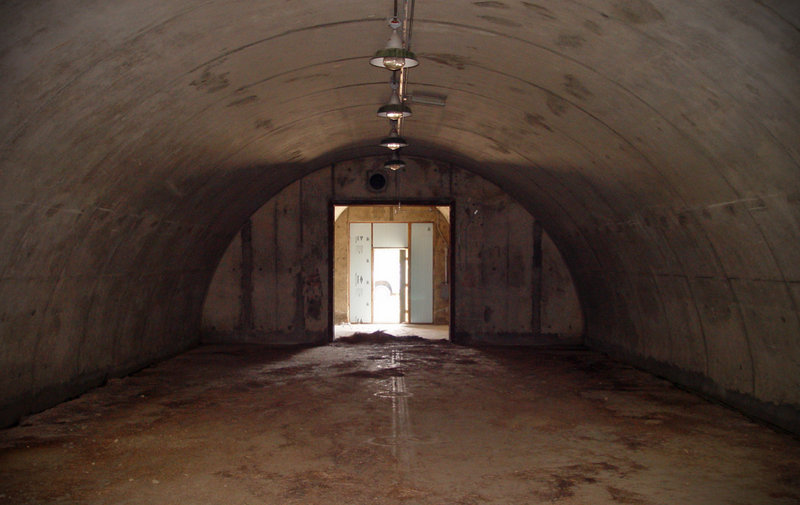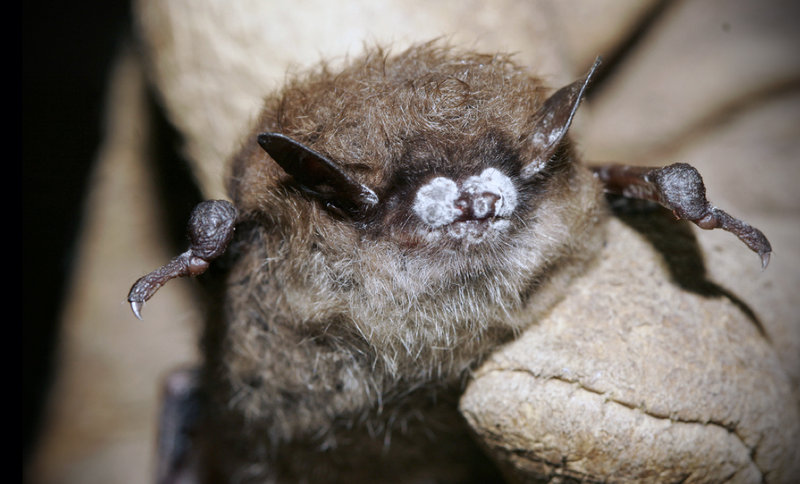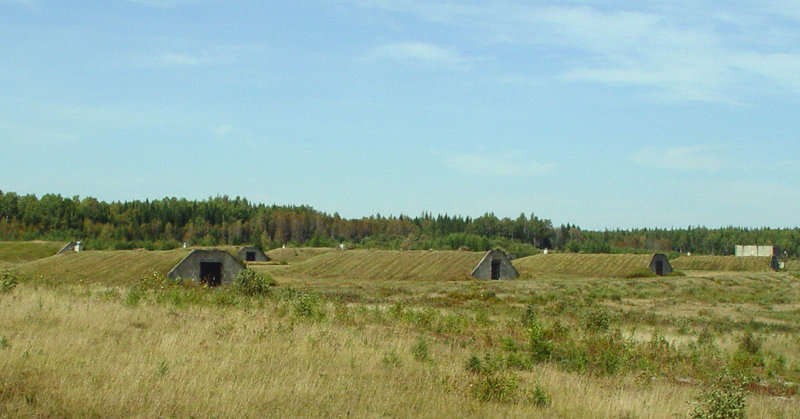The U.S. military stored nuclear weapons in half-buried concrete bunkers in northern Maine for nearly 40 years, but the Cold War is long over and the Soviet Union no longer exists, meaning the bunkers are available.
So federal wildlife officials plan to use the bunkers to take aim at a different enemy: white-nose syndrome, a fungal disease that has wiped out nearly 90 percent of little brown bats in the eastern third of the nation.
Forty-six bunkers that once stored bombs such as the Mark 4 (Fat Man), Mark 6 and Mark 17 — refinements of the bombs dropped on Hiroshima and Nagasaki — soon may provide hibernation sites for little brown bats, which are rapidly disappearing because of the cold-tolerant fungus that causes white-nose syndrome.
The disease, which has killed an estimated 5 million to 6.5 million bats nationwide, strikes most fiercely when the bats are hibernating. From October to late March or early April, bats remain in a state of torpor for long periods. Their metabolism slows and immune systems weaken because they are not feeding.
But long before bats start swarming for hibernation this fall, wildlife officials in the Aroostook National Wildlife Refuge in Limestone will be working to fabricate two artificial caves, each 15 feet high, 25 feet wide and 80 feet long.
Over the next couple of weeks, officials will try to “sterilize” the first of the old bunkers to ensure that the fungus, newly reclassified as Pseudogymnoascus destructans, has been eliminated and the structure provides a safe refuge for the bats, said assistant refuge manager Steve Agius of the U.S. Department of Interior’s Fish and Wildlife Service.
The second bunker will be left as is to mimic a natural cave and serve as a control structure to gauge whether the manipulated environment in the other hut is having any positive effect.
This experiment in survival for flying mammals marks a big transformation for the 8,200-square-mile wildlife refuge, located on part of the former Loring Air Force Base in Aroostook County. From the late 1950s into the 1980s, the bunkers housed nuclear weaponry because the base was the nearest point to Moscow in the U.S., Agius said.
The wildlife refuge, established in 1998, returned the land to conserved wild space for animals, which is the U.S. Fish and Wildlife Service’s mandate on all refuges.
But this program has taken the concept a step further, because the existing environment is being manipulated for the benefit of the bats. And it occurs at a critical juncture in the spread of white-nose syndrome, when populations of little brown bats are so heavily infected that they could be wiped out, said Ann Froschauer, spokeswoman for the U.S. Fish and Wildlife Service, which is tracking the disorder nationwide.
Bats afflicted with white-nose syndrome suffer from ulcerated, scarred or dying wing membrane tissue, possibly from being penetrated by the fungus. Infected bats essentially starve to death, but scientists have not yet figured out exactly why, according to the wildlife officials with the Department of the Interior.
The disorder is also thought to prompt bats to alter their winter behavior, causing them to move to the entrance of their hibernation caves or even emerge and fly around during daylight hours, scientists have observed. Because bats normally do not waken during hibernation to eat — rousing only occasionally to drink water — the extra activity reduces their bodies’ fat stores. Some bats cease to respond at all to stimuli, and many have been found dead both inside and outside caves.
Transmitted primarily from bat to bat, the syndrome is of particular interest to medical researchers because bats are significant predators of mosquitoes, which are vectors of disease in birds, mammals and humans. Bats also serve as major crop pollinators and provide the equivalent of $2 billion to $3 billion a year of insect pest control.
“Bats are an important component in our ecosystem,” Agius said. “All organisms are. But avian mammals are incredibly unique.”
In some places little brown bats and to a lesser extent northern long-eared bats have been almost completely eliminated, said John DePue, state small mammal biologist. “The little brown bats and northern long-eared bats have seen a precipitously large decline.”
Because the devastation to bat populations has been so profound, biologists and wildlife specialists have locked onto the question of how the disease is spread as a way to try to stop it, Agius said.
People become part of the disease equation, because spores of the fungus are thought to be accidentally transported from one place to another on people’s clothing, footwear and caving gear, Froschauer said. In fact, many researchers believe that the fungus originated in Europe and was carried to the U.S. by humans on gear used in contaminated caves abroad.
“This is essentially an invasive fungus from Europe,” said Scott Darling, Vermont state biologist, who participates in the Aroostook County experiment both by collecting and transporting bats and by helping to plan and design the research.
“We continue to be in a dire situation with bats in the Northeast,” he said. “They continue to die and if we don’t do anything, they’ll disappear.”
White-nose syndrome apparently does not afflict people, pets or livestock, but it frequently has proven deadly to at least seven species of hibernating bats, killing 90 percent or more of some species in caves where the fungus has lasted for a year or longer, according to the Fish and Wildlife Service. The fungus also has been found on two additional bat species, apparently without causing white-nose syndrome.
‘A NOAH’S ARK STRATEGY’
The first bunker in the bat-cave program at the Aroostook refuge already has been retrofitted with temperature and humidity controls, insulated doors, a thermal blanket and a layer of soil over its rounded top.
The next step is a thorough cleaning inside, probably with Dawn detergent and a steam pressure wash to remove the soap residue, which might prove toxic to the bats, Agius said.
Then, as hibernation season draws near, officials will broadcast wide-spectrum recordings of swarming calls, inaudible to humans but discernible by bats.
If all goes according to plan, some of Maine’s declining population of little brown bats — likely including some already with white-nose syndrome — might flock to the site, Agius said. Wildlife officials hope bats will be exposed to less of the fungal disease in the man-made, he said.
“It’s like the Noah’s Ark strategy,” Agius said. If things get grim enough, humans have to step in to protect species of animals that without outside intervention may disappear altogether. That means focusing efforts both on saving the animals and preserving habitat.
Creating an artificial cave — and successfully bringing bats to a bunker to hibernate — are key goals of the program, Agius said. In addition, researchers are trying to determine how to reduce the “fungal load” — or amount of infection — that sickens and kills that bats. Biologists theorize that the bats can survive exposure to the fungus to some degree, because infected populations in Europe are resistant, even though the fungus is still found there.
“The evidence suggests that it’s been there awhile,” said Darling.
Bats in the U.S. might possibly adapt and evolve resistance, too, but one question is whether they can — or will — before populations are wiped out. Every available method — including collecting bats and cleaning the fungus from their muzzles and wings — should be considered, because each has the potential to move a little closer to a solution, he said.
“As long as they’re not picking up tremendous loads of this stuff, (it) may allow them enough time to build up a resistance,” Agius said.
White-nose syndrome, so named because it leaves a white residue on the muzzles and wings of affected bats, continues to spread from the Northeast, said Froschauer.
The syndrome was first detected in bats in caves near Albany, N.Y., in 2006 and has steadily expanded into new areas. This year, it has been found in 19 states and the fungus that causes the syndrome has been confirmed in 21. The syndrome also has been detected in four Canadian provinces, she said.
“It doesn’t seem to be slowing down,” Froschauer said.
“White nose syndrome is having a quick and pervasive impact on little and big brown bats,” said Susan Gallo, a Maine Audubon wildlife biologist. “Of the 45 historic colonies identified by citizen scientists (in Maine) last year, only 12 had bats actually roosting — and none of them raised any pups.”
BIG UNDERTAKING ON TINY BUDGET
The artificial cave program at the Aroostook refuge got under way earlier this year with 30 infected male bats — half imported from Vermont and half from New York state, Agius said. The flying mammals were placed in the sealed bunker to see if they would accept an artificial cave and “behave appropriately,” by dangling upside down and snoozing. Wildlife officials re-created a somewhat stripped-down winter habitat, incorporating a small pool of water and some natural resting spots, such as hanging structures and a dead tree trunk.
All but two or three of the bats preferred the concrete walls and took up residence there, Agius said.
Throughout the winter, temperature and humidity were kept as close to the winter conditions bats seek in real caves — 35 to 37 degrees Fahrenheit and more than 90 percent humidity. Agius said he monitored the new cave by snowmobiling out to the hut every three days and checking on the bats with a motion activated camera and infrared monitoring system.
Researchers know that the mortality rate from the disease in the bunker correlated with that found in natural caves, but that does not indicate failure. Agius said biologists are still reviewing findings about how the fungus is spread.
The whole operation wracked up only about $4,000 in expenses, not counting staff time — much of which was volunteered, Agius said.
“I don’t have a budget,” Agius said, adding that he got help at various stages from researchers at Bucknell University, the University of Arizona, the University of California at Santa Cruz, state officials in Vermont and New York and other colleagues from the Fish and Wildlife Service.
“Everybody provided their own funding,” he said.
U.S. Forest Service researchers have updated the identification of the white-nose syndrome fungus initially classified as Geomyces destructans. It recently has been identified more precisely as Pseudogymnoascus destructans, Froschauer said.
The close non-disease-causing relatives of the Geomyces destructans fungus have also been identified. Researchers believe these fungi — many of them never seen before and still lacking formal Latin names for classification — may disclose clues to unravel some of the puzzles of the syndrome. Researchers hope to use these fungi for study to understand why one fungus can be deadly to bats while its close relatives are seemingly harmless.
Meanwhile, Maine Audubon — in the second year of a study conducted in partnership with the Maine Department of Inland Fisheries and Wildlife, with support provided by the Maine Outdoor Heritage Foundation — is asking Maine residents to act as citizen scientists and help identify the locations around the state of maternal bat colonies — where female bats group together to raise their young.
Little and big brown bat colonies are usually found in attics, barns, church eaves, old theaters, abandoned buildings, homes, garages and other structures. Audubon wants to locate as many bat colonies as possible, and interested volunteers can be taught how to estimate colony size by counting the number of bats emerging at dusk.
“Because of the devastation of (white nose syndome) on bat colonies, we are even looking for historical information,” Gallo said. “If you know of a bat colony that has not seen activity this year, we still want to hear about it.”
“It’s really a race against time,” biologist Darling said. “We make these bold steps and we learn something.”
North Cairn can be contacted at 791-6325 or at:
ncairn@pressherald.com
Send questions/comments to the editors.





Success. Please wait for the page to reload. If the page does not reload within 5 seconds, please refresh the page.
Enter your email and password to access comments.
Hi, to comment on stories you must . This profile is in addition to your subscription and website login.
Already have a commenting profile? .
Invalid username/password.
Please check your email to confirm and complete your registration.
Only subscribers are eligible to post comments. Please subscribe or login first for digital access. Here’s why.
Use the form below to reset your password. When you've submitted your account email, we will send an email with a reset code.